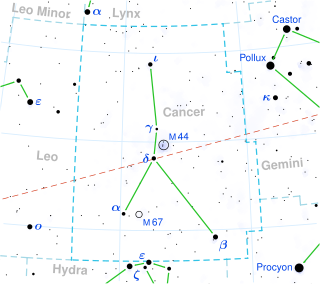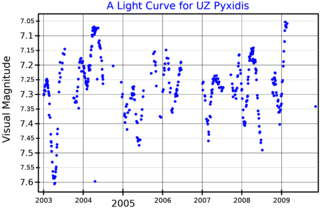
Tau Virginis is a single star in the zodiac constellation Virgo. With an apparent visual magnitude of 4.28, it is faintly visible to the naked eye. The distance to Tau Virginis, based upon parallax measurements, is approximately 225 light years with a margin of error of ±3 light years.

UU Aurigae is a carbon star in the constellation Auriga. It is approximately 341 parsecs from Earth.
Chi Boötis, Latinised as χ Boötis, is a single, white-hued star in the northern constellation Boötes, near the eastern constellation border with Corona Borealis. It is faintly visible to the naked eye with an apparent visual magnitude of +5.3. Based upon an annual parallax shift of 13.0 mas as seen from the Earth, it is located about 251 light-years from the Sun. The star is moving closer to the Sun with a radial velocity of −16 km/s.
HD 42818 is a suspected astrometric binary star system in the northern circumpolar constellation of Camelopardalis. It is visible to the naked eye with an apparent visual magnitude of +4.76. Based upon an annual parallax shift of 18.64±0.23 mas as seen from Earth's orbit, it is located some 175 light years away. The system appears to be moving closer with a heliocentric radial velocity of −7 km/s. As of 2012, it is estimated that the system will make its closest approach to the Sun in 485,000 years at a distance of around 169.2 ly (51.87 pc).

Pi Cassiopeiae, Latinized from π Cassiopeiae, is a close binary star system in the constellation Cassiopeia. It is visible to the naked eye with an apparent visual magnitude of +4.949. Based upon an annual parallax shift of 18.63 mas as seen from Earth, this system is located about 175 light years from the Sun.

R Andromedae is a Mira-type variable star in the constellation Andromeda. Its spectral class is type S because it shows absorption bands of zirconium monoxide (ZrO) in its spectrum. It was among the stars found by Paul Merrill to show absorption lines of the unstable element technetium, establishing that nucleosynthesis must be occurring in stars. The SH molecule was found for the first time outside earth in the atmosphere of this star. The star is losing mass due to stellar winds at a rate of 1.09×10−6M☉/yr.

V Aquilae is a carbon star and semiregular variable star in the constellation Aquila. It has an apparent magnitude which varies between 6.6 and 8.4 and is located around 400 parsecs (1,300 ly) away.

CQ Camelopardalis, abbreviated as CQ Cam, is a solitary variable star in the northern circumpolar constellation Camelopardalis. It has an apparent magnitude of 5.19, making it visible to the naked eye under ideal conditions. The object is relatively far at a distance of about 2,000 light years but is drifting closer with a heliocentric radial velocity of −22 km/s. It has a peculiar velocity of 21.8+2.1
−1.9 km/s, making it a runaway star.
16 Camelopardalis is a single star in the northern circumpolar constellation Camelopardalis, located 348 light years away from the Sun as determined from parallax measurements. It is visible to the naked eye as a faint, white-hued star with an apparent visual magnitude of 5.28. This object is moving further from the Earth with a heliocentric radial velocity of around 12 km/s.
4 Camelopardalis is a probable multiple star in the northern constellation of Camelopardalis, located 177 light years away from the Sun, based upon parallax. With a combined apparent visual magnitude of 5.29, it is visible to the naked eye as a faint, white-hued star. The pair have a relatively high proper motion, traversing the celestial sphere at an angular rate of 0.158″ per year. The system's proper motion makes it a candidate for membership in the IC 2391 supercluster. They are moving away from the Earth with a heliocentric radial velocity of 22.5 km/s.
HR 3082 is a double star in the northern circumpolar constellation of Camelopardalis. It is faintly visible to the naked eye with an apparent visual magnitude of 5.39. The system is moving closer to the Sun with a heliocentric radial velocity of +2.7 km/s. It is currently at a distance of around 323 light years, based upon an annual parallax shift of 10.10±0.24 mas.

Pi Herculis is a third-magnitude star in the constellation Hercules. As one of the four stars in the Keystone asterism, it is one of the constellation's more easily recognized. It has an apparent visual magnitude of +3.2, which is visible to the naked eye and makes it one of its brighter members. The Hipparcos satellite mission estimated its distance at roughly 115 parsecs from Earth, or about 377 light years away. The overall reduction in the star's visual magnitude due to extinction from the intervening matter is 0.11.
21 Camelopardalis is a star in the northern circumpolar constellation of Camelopardalis, located around 650 light years away from the Sun. It is a challenge to view with the naked eye even under excellent viewing conditions, having an apparent visual magnitude of 6.9. This is one of the fainter stars with a Flamsteed designation, one of only 220 below the magnitude cutoff for the Bright Star Catalogue. It is moving closer to the Earth with a heliocentric radial velocity of −15.5 km/s.
30 Camelopardalis is a star in the northern circumpolar constellation of Camelopardalis, located about 539 light years away from the Sun based on parallax. It can be viewed with the naked eye in good seeing conditions, appearing as a dim, white-hued point of light with an apparent visual magnitude of 6.14. This is most likely a slowly rotating A-type main-sequence star with a stellar classification of A0Vs, which indicates it is generating energy via hydrogen fusion at its core. It is moving further from the Earth with a heliocentric radial velocity of +12 km/s.

X Cancri is a variable star in the northern constellation of Cancer. It has a red hue and is visible to the naked eye at its brightest. The distance to this object is approximately 1,860 light years based on parallax measurements, but is drifting closer with a radial velocity of −5 km/s. It lies very close to the ecliptic and so is subject to lunar occultations.

UZ Pyxidis is a semiregular variable star in the constellation Pyxis. It is located about 3,600 light-years away from the Earth.
λ Librae is the Bayer designation for a binary star system in the zodiac constellation of Libra. It can be faintly seen with the naked eye, having an apparent visual magnitude of 5.03. With an annual parallax shift of 10.54 mas, it is roughly 310 light years from the Sun. At that distance, the visual magnitude of this system is diminished by an extinction factor of 0.22 due to interstellar dust. It is 0.1 degree north of the ecliptic.

V915 Scorpii is an orange hypergiant variable star in the constellation Scorpius.

HD 26764, also known as HR 1314 or rarely 14 H. Camelopardalis, is a solitary white hued star located in the northern circumpolar constellation Camelopardalis. It has an apparent magnitude of 5.19, making it faintly to the naked eye if viewed under good conditions. Gaia DR3 parallax measurements place the object at a distance of 266 light years and is drifting closer with a poorly constrained heliocentric radial velocity of 3 km/s. At its current distance, HD 26764's brightness is diminished by 0.26 magnitudes due to interstellar dust.

HD 27022, also known as HR 1327, is a star located in the northern circumpolar constellation Camelopardalis. The object has also been designated as 20 H. Camelopardalis, but is not commonly used in modern times. It has an apparent magnitude of 5.27, allowing it to be faintly visible to the naked eye. Based on parallax measurements from Gaia DR3, the star has been estimated to be 347 light years away. It appears to be approaching the Solar System, having a heliocentric radial velocity of −19.5 km/s.












